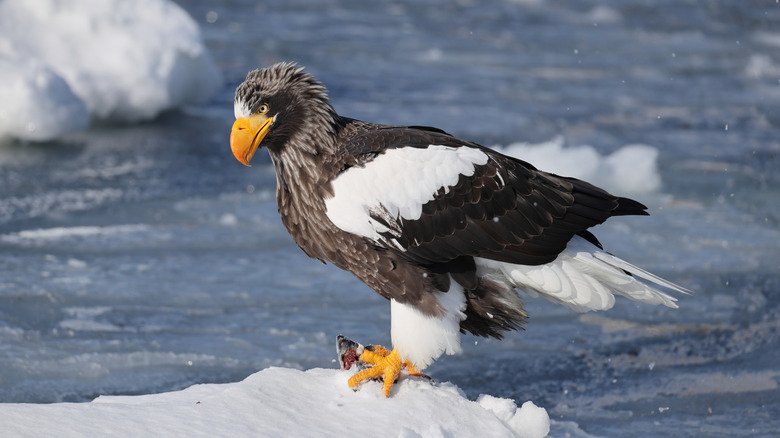A Rare Eagle Has Appeared In North America For The First Time - And It's Huge
Whether spotting the cutest little owl or a large majestic eagle, seeing a bird of prey in its natural habitat is always a welcome spectacle. For avid bird watchers in North America, there are opportunities to see up to 35 different unique species of the winged hunters. However, some visitors at Eastern Canada's Terra Nova National Park got a once-in-a-lifetime chance to encounter the large and scarce Steller's sea eagle.
This bird is currently listed as vulnerable on the International Union for Conservation of Nature Red List, with a declining population estimated between 3,600 and 4,670. The eagle is native to the coastal regions and rivers of northeastern Siberia, Russia, with a portion of the population migrating to the Kuril Islands and Hokkaido, Japan. However, this is the first time the Steller's sea eagle has been spotted in North America. Pictures of the unlikely visitor appeared at the end of 2024, when photographer Sandra Moss captured the bird on camera during a visit. The rare sighting prompted the park to open up for the winter season, allowing others a chance to catch a glimpse of the uncommon bird of prey.
An extraordinary sight, it is difficult to miss the Steller's sea eagle, which is larger than the more common bald eagle found throughout North America. The Steller's sea eagle grows to a length between 34 and 41 inches, with a wingspan between 6 feet 5 inches and 8 feet 2 inches. The spotting of this massive eagle, while a remarkable experience, also highlights the unfortunate decline of one of nature's fiercest predators.
Why the sighting of a Steller's sea eagle is so rare
There is much that scientists and conservationists don't know about the Steller's sea eagle. Its lifespan is estimated to be around 20 to 25 years, assuming it's similar to its close relative, the white-tailed sea eagle. It reaches sexual maturity around six to seven years old and forms monogamous pairings, laying one to three eggs. The eagle species has no known predators, but bears, crows, and martens can pose a threat to its eggs. Whether the Steller's sea eagle is among the best bird mothers in the animal kingdom isn't known, as little is documented about how they raise their young beyond the fact that they co-parent.
The lack of research and limited populations of the Steller's sea eagle has led to speculation about its decline. As a species that primarily preys on fish, overfishing, industrial activity in its natural habitats, and pollution are all likely contributing factors in the continued decline of the species. Other challenges that the sea eagle faces include cases of avian pox and nesting failures due to predators. Conservation efforts have been made in both Russia and Japan to preserve the eagle's habitat and provide nesting areas; however, the encroachment of industry still poses a continuous threat to the raptor.
The future of the Steller's sea eagle remains uncertain, with the unprecedented sighting at Terra Nova National Park in Canada perhaps the only opportunity Americans will have to see one in the wild. Want to read more about rare animal findings? Check out the unique "One-In-A-Million" animal spotted in western Texas.

